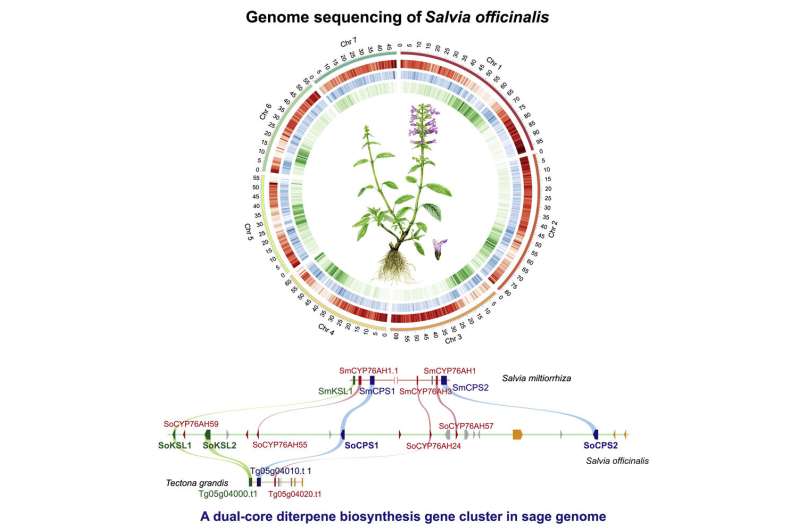Sage genome provides insight into evolution of diterpenoids of medicinal interest

Salvia officinalis (S. officinalis), known as sage or common sage, and the Chinese sage (S. miltiorrhiza), or Danshen (red sage) in Chinese, belong to the family of Lamiaceae and have a long history of cultivation for medicinal uses in Europe and East Asian regions, respectively.
Recently, an international team of researchers from China (CAS Center for Excellence in Molecular Plant Sciences, Shanghai Chenshan Botanical Garden, and Fudan University) and the U.K. (John Innes Center), has generated a high-quality genome of sage and revealed the evolutionary features of diterpenoids biosynthesis in Salvia. The study has been published in Cell Reports.
S. officinalis, native to the Mediterranean, produces diterpenoids in both root and shoot (leaf) tissues. In contrast, the East Asian species S. miltiorrhiza accumulates a specific group of diterpenoid quinones, called tanshinones, in root only. Comparison of the genomes of these two species revealed that both have a diterpene biosynthesis gene cluster (BGC). In S. officinalis, the BGC harbors two sets of genes responsible for the diterpenoid production in root and shoot, respectively, whereas in S. miltiorrhiza one part of the gene cluster has contracted and the shoot diterpene pathway has been lost, leading to the restriction of the diterpene metabolites to the root.
Phylogenomic analysis indicated that the Salvia clades diverged in the early Miocene. In the Mediterranean and Europe, many Salvia species are perennial shrubs, but in East Asia, most species are herbaceous perennials, surviving the cold and humid winter with storage root. Notably, in Chinese sage S. miltiorrhiza one part of the gene cluster has contracted and the shoot diterpene pathway has been lost.
The differences in gene cluster compositions as well as in the compound structures provide a genomic insight of micro-evolution of growth habit-associated patterning of the production of specialized metabolites in plants, which is valuable for molecular breeding and cultivation of medicinal plants.
More information: Chen-Yi Li et al, The sage genome provides insight into the evolutionary dynamics of diterpene biosynthesis gene cluster in plants, Cell Reports (2022). DOI: 10.1016/j.celrep.2022.111236
Journal information: Cell Reports
Provided by Chinese Academy of Sciences





















